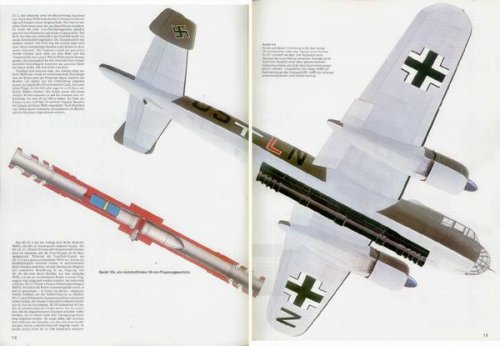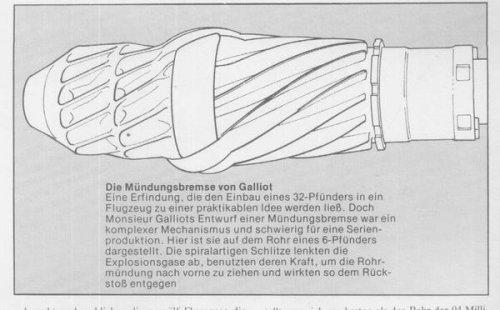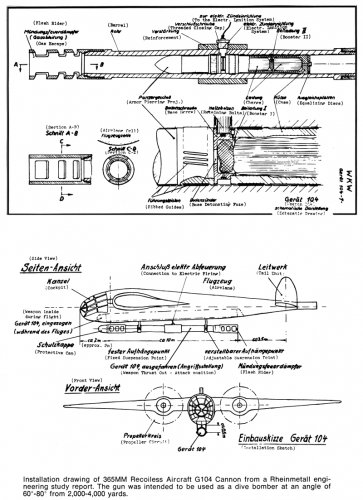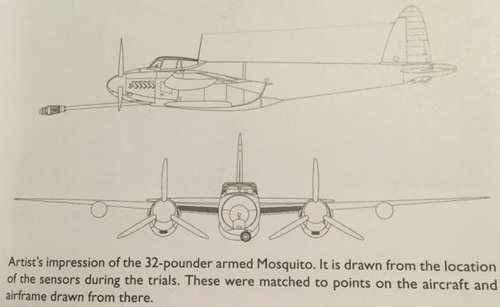I have seen reference to this (94mm or 32 pdr) in two or 3 places (details if anyone wants them) implying that it was a. considered, and b. in another place, actually built and flown postwar. Does anyone have confirmation, drawings, picture, please?
You are using an out of date browser. It may not display this or other websites correctly.
You should upgrade or use an alternative browser.
You should upgrade or use an alternative browser.
Mosquito with a 32-Pounder
- Thread starter smurf
- Start date
- Joined
- 22 January 2006
- Messages
- 4,213
- Reaction score
- 2,010
I haven't heard about it, possibly Lark can add something.
From page 72-73 British Secret Projects 1935-50 (Tony Buttler) : A conversion for the Mosquito to take the AT 6 pounder cannon was proposed by 1943.
The biggest cannon I know to be planned for an aircraft was a 280 mm in a Ju-288 antiship version
in a Ju-288 antiship version
From page 72-73 British Secret Projects 1935-50 (Tony Buttler) : A conversion for the Mosquito to take the AT 6 pounder cannon was proposed by 1943.
The biggest cannon I know to be planned for an aircraft was a 280 mm
Hi, new member (just discovered this wonderful site).
If the 94mm is the same as the 17pdr anti-tank gun then this isn't a joke. One of my Ian Hogg books (I'll try and dig it out when I get home) mentions that there was a serious plan to fit the 17pdr anti-tank gun into the Mosquito. A special devise had to be designed to help the airframe withstand the massive recoil.
In the end it was decided that rockets were the way to go and no further work was done (no real suprise).
One of the Italian Piaggio P.108 bombers had a 102mm (4-inch) gun fitted for anti-shipping use.
If the 94mm is the same as the 17pdr anti-tank gun then this isn't a joke. One of my Ian Hogg books (I'll try and dig it out when I get home) mentions that there was a serious plan to fit the 17pdr anti-tank gun into the Mosquito. A special devise had to be designed to help the airframe withstand the massive recoil.
In the end it was decided that rockets were the way to go and no further work was done (no real suprise).
One of the Italian Piaggio P.108 bombers had a 102mm (4-inch) gun fitted for anti-shipping use.
A funny history about Ju-88 guns...
After WWII france build around 70 Ju-88 which were used as testbed (for ramjets!) until 1954 (that's not a joke!)
One of the units flying Ju-88 was located in north Africa. They had
Ju-88c night fighters, with gun in the nose...
First time they tried the gun (on the ground) was quite fun. The plane was in front of the target, they fired the gun and...the shell flew above the target, and felt 4 km farther, in the hangar of an Aeronavale base!
After WWII france build around 70 Ju-88 which were used as testbed (for ramjets!) until 1954 (that's not a joke!)
One of the units flying Ju-88 was located in north Africa. They had
Ju-88c night fighters, with gun in the nose...
First time they tried the gun (on the ground) was quite fun. The plane was in front of the target, they fired the gun and...the shell flew above the target, and felt 4 km farther, in the hangar of an Aeronavale base!
- Joined
- 22 January 2006
- Messages
- 4,213
- Reaction score
- 2,010
I'll try and dig it out when I get home
Wellcome eltf177
In the end it was decided that rockets were the way to go and no further work was done (no real suprise)
For the same reason the highly specialized Martin-Baker "Tankbuster" was cancelled in 1943
While waiting for more info I post the Ju-288 with 280 mm canon
Source: Die Deutsche Luft-Rüstung 1933-1945 Vol 3
Heinz J Nowarra
Ed: Bernard&Graefe
Attachments
- Joined
- 22 January 2006
- Messages
- 4,213
- Reaction score
- 2,010
I have this:
Fig 87 pg 120 "Junkers Ju 288 mit rückstossfreier 28-cm-Kanone"
on page 121 we can read the following entry:
"Junkers Ju-288 G-Reihe
Projektierte Version mit 1 x 35,5 cm-Kanone im Bombenraum, die beim Einsatz gegen Schiffsziele durch ben Bug ausgefahren werden sollte"
My knowledge of German Language is very basic...can our German friends give a little help ? (Boxkite or Jemiba)
Fig 87 pg 120 "Junkers Ju 288 mit rückstossfreier 28-cm-Kanone"
on page 121 we can read the following entry:
"Junkers Ju-288 G-Reihe
Projektierte Version mit 1 x 35,5 cm-Kanone im Bombenraum, die beim Einsatz gegen Schiffsziele durch ben Bug ausgefahren werden sollte"
My knowledge of German Language is very basic...can our German friends give a little help ? (Boxkite or Jemiba)
Meteorit said:Do you have the designation of that gun?
Geheimprojekte der Luftwaffe Band III designates it as the Düsenkanone 28cm, or Düka 280. The gun would have fired a 400kg projectile at 560 m/s muzzle speed, penetrating up to 200mm armour.
pometablava said:on page 121 we can read the following entry:
"Junkers Ju-288 G-Reihe
Projektierte Version mit 1 x 35,5 cm-Kanone im Bombenraum, die beim Einsatz gegen Schiffsziele durch ben Bug ausgefahren werden sollte"
My knowledge of German Language is very basic...can our German friends give a little help ? (Boxkite or Jemiba)
The 33,5 cm gun(Gerät 104 "Munchausen") was a recoilless gun carried below the fuselage; it measured 11.25 meters long, and it would have fired a 700 kg projectile at 280 m/s.
- Joined
- 11 March 2006
- Messages
- 8,625
- Reaction score
- 3,805
"Junkers Ju-288 G-Reihe
Projektierte Version mit 1 x 35,5 cm-Kanone im Bombenraum, die beim Einsatz gegen Schiffsziele durch ben Bug ausgefahren werden sollte"
=
Junkers Ju 288 G-Series
planned version with a 35,5cm gun < 14in> in the bomb bay, for use against ships extendable
through the bow
Projektierte Version mit 1 x 35,5 cm-Kanone im Bombenraum, die beim Einsatz gegen Schiffsziele durch ben Bug ausgefahren werden sollte"
=
Junkers Ju 288 G-Series
planned version with a 35,5cm gun < 14in> in the bomb bay, for use against ships extendable
through the bow
- Joined
- 11 March 2006
- Messages
- 8,625
- Reaction score
- 3,805
Ah, people, who are very tidy, are just too lazy for searching !
"Münchhausen-Gerät" was a good clue, I knew, it was mentioned somewhere ..
About 30 years ago, I've bought a series of paperbacks, not what I would call
good and reliable today, but nevertheless, two issues, one about german, the
other about allied secret weapons mention the "Gerät 104" and the 32 pdr
gun in the Mosquito.
The SG 104 is shown under a Do 217 and not inside the bomb bay, as with
the Ju 288.
Of the 32 pdr, just the recoil damper (?) is shown, designed by Monsieur Galliot.
"Münchhausen-Gerät" was a good clue, I knew, it was mentioned somewhere ..
About 30 years ago, I've bought a series of paperbacks, not what I would call
good and reliable today, but nevertheless, two issues, one about german, the
other about allied secret weapons mention the "Gerät 104" and the 32 pdr
gun in the Mosquito.
The SG 104 is shown under a Do 217 and not inside the bomb bay, as with
the Ju 288.
Of the 32 pdr, just the recoil damper (?) is shown, designed by Monsieur Galliot.
Attachments
Thank you all for your efforts. The gun is not the 17 pdr, but its potential successor, the 32 pdr, roughly comparable with the 94mm AA gun. Ian Hogg was one of my sources, but I think he is actually just quoting one of the others. The DH design team was according to British Aircraft Armament Raf Guns And Gunsights From 1914 To The Present Day
Clarke, R.Wallace asked about upgrading the Molins 57mm 6pdr to 17 pdr, with the response that the stress calculations had already been done for the 32 pdr. The other claiming an actual post war flight and firing trials iis one of the early histories of the Mosquito, but as we moved recently my books are still packed and I can't check which one. On the other hand, no other books mention it and the DH museum in Hatfield was dismissive. So, any evidence?
Clarke, R.Wallace asked about upgrading the Molins 57mm 6pdr to 17 pdr, with the response that the stress calculations had already been done for the 32 pdr. The other claiming an actual post war flight and firing trials iis one of the early histories of the Mosquito, but as we moved recently my books are still packed and I can't check which one. On the other hand, no other books mention it and the DH museum in Hatfield was dismissive. So, any evidence?
Sorry about this. More haste less speed! The gun was [to be?] fitted with a Galiot muzzle brake. The 'secret weapons' books were specials in Purnell's History of WWII part-work series. The article on the 32 pdr Mosquito and the Galiot muzzle brake was by Ian Hogg, a very respected writer on artillery, but not always consistent. As I said, I think he was quoting my other source.
... a heavy gun installation had been considered.Mounting a
3.7 in. (94mm) anti-aircraft gun into a Mosquito and on
4 December 1942 a ground attack version with extra armour
plating were discussed and weight estimates made.
So far "Mosquito" by C.Martin Sharp and Michael J.F.Bowyer
Creycy Pubications - 1995
No illustration...
3.7 in. (94mm) anti-aircraft gun into a Mosquito and on
4 December 1942 a ground attack version with extra armour
plating were discussed and weight estimates made.
So far "Mosquito" by C.Martin Sharp and Michael J.F.Bowyer
Creycy Pubications - 1995
No illustration...
- Joined
- 3 June 2011
- Messages
- 18,335
- Reaction score
- 12,236
Jemiba said:Ah, people, who are very tidy, are just too lazy for searching !
"Münchhausen-Gerät" was a good clue, I knew, it was mentioned somewhere ..
About 30 years ago, I've bought a series of paperbacks, not what I would call
good and reliable today, but nevertheless, two issues, one about german, the
other about allied secret weapons mention the "Gerät 104" and the 32 pdr
gun in the Mosquito.
The SG 104 is shown under a Do 217 and not inside the bomb bay, as with
the Ju 288.
Of the 32 pdr, just the recoil damper (?) is shown, designed by Monsieur Galliot.
Those look like pages from the series "Weapons and Warfare" yes?
- Joined
- 22 January 2006
- Messages
- 4,213
- Reaction score
- 2,010
Another source for information about German aircraft heavy cannons is:
Lufwaffe Secret Projects. Ground Attack & Special Purpose Aircraft. Dieter Herwig and Heinz Rode. Midland
http://www.amazon.com/Luftwaffe-Secret-Projects-Special-Aircraft/dp/1857801504/sr=1-1/qid=1169997557/ref=pd_bbs_sr_1/102-6849275-0167308?ie=UTF8&s=books
Gerat 104 munchhausen is on page 259
Dusenkanone Duka 280 is on page 262
That weapons had more penetrating power than any bomb so they were excelent against hardened land targets and ships.
Lufwaffe Secret Projects. Ground Attack & Special Purpose Aircraft. Dieter Herwig and Heinz Rode. Midland
http://www.amazon.com/Luftwaffe-Secret-Projects-Special-Aircraft/dp/1857801504/sr=1-1/qid=1169997557/ref=pd_bbs_sr_1/102-6849275-0167308?ie=UTF8&s=books
Gerat 104 munchhausen is on page 259
Dusenkanone Duka 280 is on page 262
That weapons had more penetrating power than any bomb so they were excelent against hardened land targets and ships.
J
joncarrfarrelly
Guest
- Joined
- 25 January 2020
- Messages
- 1,279
- Reaction score
- 1,953
Hello everyone,
I was recently searching through the internet when I found a drawing of a De Havilland Mosquito with a 32-pounder (94 mm) gun in the nose. I would like to know whether it was a real project or not and whether anyone had heard about it. I would also like to know, if it is real, whether anyone has any information about it and what was the driving force behind it.
Thanks in advance,
Wyvern
I was recently searching through the internet when I found a drawing of a De Havilland Mosquito with a 32-pounder (94 mm) gun in the nose. I would like to know whether it was a real project or not and whether anyone had heard about it. I would also like to know, if it is real, whether anyone has any information about it and what was the driving force behind it.
Thanks in advance,
Wyvern
Attachments
- Joined
- 19 July 2016
- Messages
- 4,279
- Reaction score
- 3,463
Would that not just invite the airframe to separate into component parts on firing?
- Joined
- 25 January 2020
- Messages
- 1,279
- Reaction score
- 1,953
Probably
- Joined
- 18 October 2006
- Messages
- 4,211
- Reaction score
- 4,919
Would that not just invite the airframe to separate into component parts on firing?
Which I will venture a guess that it never went much further than pondering over a pint.
- Joined
- 19 July 2016
- Messages
- 4,279
- Reaction score
- 3,463
It is a fascinating find and makes me wonder what they would do with it, anti-shipping strike?
- Joined
- 28 November 2006
- Messages
- 711
- Reaction score
- 734
IMHO both threads should be merged and moved to Early Projects section.
Piotr
- Joined
- 9 October 2009
- Messages
- 21,973
- Reaction score
- 13,625
The plane was in front of the target, they fired the gun and...the shell flew above the target, and felt 4 km farther, in the hangar of an Aeronavale base!
Inter-service rivalry at it's finest.
- Joined
- 25 January 2020
- Messages
- 1,279
- Reaction score
- 1,953
Agreed
Done !
Done !
Last edited by a moderator:
... a heavy gun installation had been considered.Mounting a
3.7 in. (94mm) anti-aircraft gun into a Mosquito and on
4 December 1942 a ground attack version with extra armour
plating were discussed and weight estimates made.
So far "Mosquito" by C.Martin Sharp and Michael J.F.Bowyer
Creycy Pubications - 1995
No illustration...
I have the Faber & Faber issue, but I can't find that reference in it. Which chapter would it come under ?
From memory, the 32 pdr was intended to fire proximity-fuzed HE shells at bombers.I was recently searching through the internet when I found a drawing of a De Havilland Mosquito with a 32-pounder (94 mm) gun in the nose. I would like to know whether it was a real project or not and whether anyone had heard about it. I would also like to know, if it is real, whether anyone has any information about it and what was the driving force behind it.
- Joined
- 25 January 2020
- Messages
- 1,279
- Reaction score
- 1,953
No it is believed that it actually flew and successfully fired the gun. David Lister's "Forgotten Tanks and Guns of the 1920s, 1930s and 1940s" mentions the typeWould that not just invite the airframe to separate into component parts on firing?
Which I will venture a guess that it never went much further than pondering over a pint.
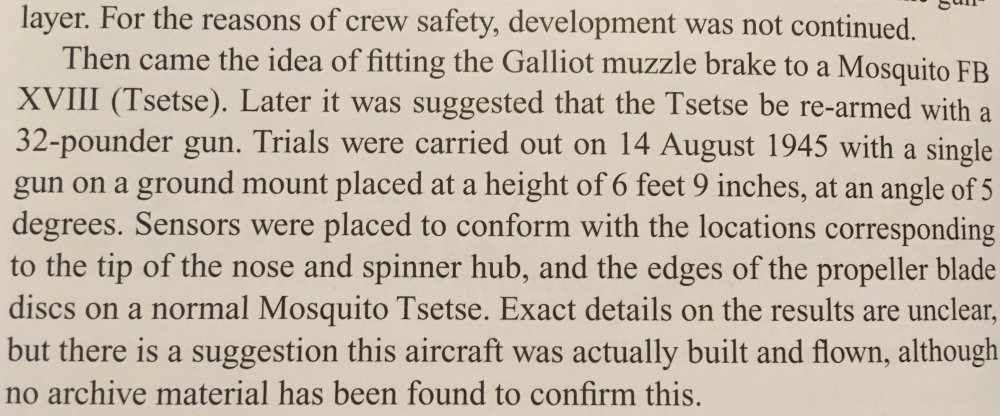
I haven't found any photos of it, and if it did really take flight and fire, most records would have probably been buried in an archive, hidden from public view.
- Joined
- 19 July 2016
- Messages
- 4,279
- Reaction score
- 3,463
I worked out the millimetric equivalent at 134mm aproximately, given that a 20 pounder is about 84mm. Somewhat bigger than the L.11 I used to operate. Quite some recoil on that monster.
- Joined
- 25 January 2020
- Messages
- 1,279
- Reaction score
- 1,953
I wonder how it affected the aerodynamics and flight characteristics......
- Joined
- 19 July 2016
- Messages
- 4,279
- Reaction score
- 3,463
We would need to know more about the weapon weight and placement in the airframe, not to mention the number of shells carried and some kind of autoloader, Not to mention the barrel length and weight. From memory the barrel alone is about 1 ton. Depending on balance it might fly nose heavy.
- Joined
- 6 September 2006
- Messages
- 4,834
- Reaction score
- 9,457
On the balance of evidence, there is proof that the static tests occurred but there is none whatsoever that a real gun was flown and fired.
It would seem improbable that such an amount of records on the structural work, work required to develop an autoload and flight testing would be missing given the mass of information on all the other Mosquito variants. I think the legend of the Tsetse mossies grew in the telling post-war and conflated with the static trials undertaken.
It would seem improbable that such an amount of records on the structural work, work required to develop an autoload and flight testing would be missing given the mass of information on all the other Mosquito variants. I think the legend of the Tsetse mossies grew in the telling post-war and conflated with the static trials undertaken.
The 32-pounder was 3.7" bore, being derived from the 3.7" AA gun.I worked out the millimetric equivalent at 134mm aproximately, given that a 20 pounder is about 84mm. Somewhat bigger than the L.11 I used to operate. Quite some recoil on that monster.
I'm not entirely certain about that. I suspect that the gun was the 32 pdr anti-tank gun which was fitted to the massive Tortoise AFV. This also had a 3.7 inch calibre but fired different ammunition from the AA gun.The 32-pounder was 3.7" bore, being derived from the 3.7" AA gun.
True that it fired different ammunition, but the 32-pdr AT was derived from the 3.7", no? Or they changed it so much it essentially became a different design?I'm not entirely certain about that. I suspect that the gun was the 32 pdr anti-tank gun which was fitted to the massive Tortoise AFV. This also had a 3.7 inch calibre but fired different ammunition from the AA gun.The 32-pounder was 3.7" bore, being derived from the 3.7" AA gun.
- Joined
- 11 February 2007
- Messages
- 2,567
- Reaction score
- 4,379
I believe you're confusing the 32 pdr AT with the Fort Halstead 4.5" recoilless proposed for F.43/46 and various other early post-war jet fighters.From memory, the 32 pdr was intended to fire proximity-fuzed HE shells at bombers.
Similar threads
-
-
de Havilland project between the DH 102 Mosquito II and the DH 103 Hornet?
- Started by BarnOwlLover2
- Replies: 8
-
-
-


